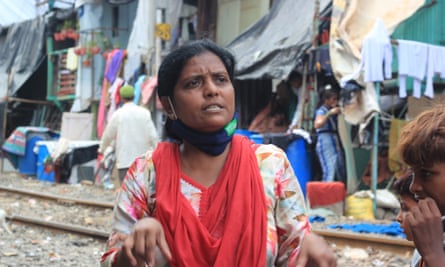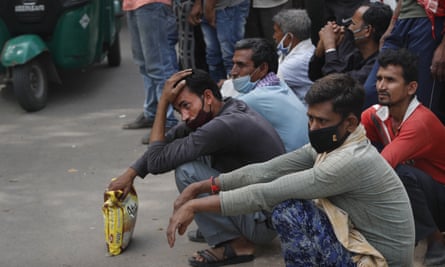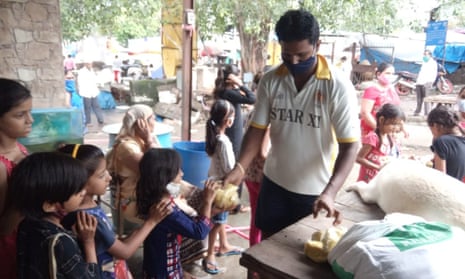When India’s devastating second wave of Covid-19 struck in April, Nazia Habib Khan’s second marriage abruptly came to an end after a year of beatings and abuse. The 28-year-old daughter of migrants from the southern Indian state of Andhra Pradesh returned to live with her mother, brothers and a sister-in-law in Mumbai.
Their 40 sq metre (400 sq ft) home in Kurla East stands huddled among the 800 or so brick, tin sheet and tarpaulin houses of Qureshi Nagar, the entire shanty town trembling when a train roars past on a nearby railway line.
Once on the housekeeping staff at a hospital and later a domestic help who washed utensils and floors, Khan is now without work, income or savings. To keep tensions and arguments in her overcrowded home to a minimum, she waits every morning and evening for a small package of food from a community kitchen operated by a women’s savings group.
Khan has been entirely dependent on food aid since the kitchen was launched in April to supply free meals to the slum’s impoverished, jobless residents. She comes every day, for lunch and dinner for herself and her two daughters, aged 10 and 11 months.

“My own earning is zero, so I try not to let my children’s food be an additional expense for my family,” says Khan. One night last week, her toddler was running a high fever and Khan couldn’t leave the house. She asked a neighbour’s 10-year-old boy to collect the dinners of khichdi (rice and lentils), roti sabzi (bread and vegetables) or a pulao rice dish. “The alternative was to sleep hungry.”
Khan and her daughters are among millions of Indians unable to access subsidised rice and wheat under India’s National Food Security Act (NFSA), a 2013 law that entitles 75% of the rural population and 50% of the urban population to receive highly subsidised food through the targeted public distribution system (TPDS). Two-thirds of Indians are eligible to receive quotas in different categories on presenting their ration card at designated “fair-price shops”. The TPDS is one of the world’s largest food-distribution networks.
India’s domestic migrants, long unable to access their right to food because they live away from their home states where they are registered for the benefits, face more hunger and desperation today than at any time in the past two decades. Analysis by Pew Research in March found that the number of India’s poorest people – those earning $2 or less a day – had increased by 75 million due to the recession brought on by Covid.
The Kurla slum is home to day labourers and women who work as domestic help or maids, all migrants from other states, whose ration cards are registered at their home addresses or who have no ration card at all.
Khan’s neighbours include drivers whose families collect their quota of grains from their homes in Uttar Pradesh, as well as men from Tamil Nadu’s poorest villages living in groups who make a living selling idlis (steamed rice cakes). There are also itinerant vendors of detergent and steel wool, originally from Uttar Pradesh, Bihar and Rajasthan. Work and incomes have shrunk dramatically across most households. The month of April 2020 alone saw 122 million Indians lose their jobs, including almost all day labourers.

The Kurla community kitchen that Khan depends on has sought more funding as the number of poor and hungry who use it grows. “We are supplying 1,300 meals every day now,” says Sujata Sawant, who runs the kitchen. “And 90% of those who take our food do not have any other source.”
In 2020, Sawant mobilised donations for 14,500 grocery parcels but in the two months since the second lockdown in May this year, she has already distributed 4,500 of them.
On 29 June, responding to Covid-induced distress among migrant workers in towns and cities across India, the supreme court ordered key reforms including expediting the rollout of a “one nation, one ration card” scheme to allow migrants to buy subsidised grain from outlets anywhere in the country, while their families continue to claim their entitlement at home. The country’s top court set a deadline of 31 July for this and also ordered registration of all casual and migrant workers, and community kitchens to be set up for labourers until at least the end of the pandemic.
“This will still leave out the millions who do not have ration cards at all,” says Mukta Srivastava, Maharashtra state’s convener for the Right to Food Campaign, a coalition of civil society groups whose lobbying led to the NFSA being enacted. “This exclusion in the current economic conditions exacerbates hunger,” she says.
Currently, the NFSA benefits about 800 million people. But 67% of India’s 1.3 billion population is supposed to be eligible. The shortfall from the legally mandated coverage is more than 100 million, according to estimates by the economists Jean Drèze, Reetika Khera and Meghna Mungikar.
During the pandemic, the number of Indians living below the international poverty line (less than $2 a day) has grown. One of the court’s directives was to consider re-determining the total number of NFSA beneficiaries. Yet, despite the pandemic’s effects on jobs and the economy, the government’s top thinktank, the National Institution for Transforming India (NITI Aayog), reportedly recommended a cut in the percentages of people covered in rural and urban areas, reducing total coverage of the food security law.

Sawant says cardholders are often unable to obtain their full quota, are turned away by shop owners or cheated with low quantities. Some items such as paraffin, a key domestic fuel, are no longer provided through the TPDS. “Can a slum dweller without a job afford a cooking gas cylinder that costs 900 rupees [£9]?” asks Sawant.
Repeated increases in fuel tax have led to soaring prices, further eroding disposable incomes and putting more basic goods out of reach for millions of Indians. The first week of July alone recorded five increases in petrol prices and three in diesel; June and May each witnessed 16 separate price rises for diesel and petrol.
Srivastava, the right to food campaigner, said the other challenge in implementing the supreme court order was the technical problems involved. For the card to be used everywhere, all states must have electronic terminals, or EPOS machines, and the verifiable 12-digit identification number for the vast biometric Aadhaar system used in the machines have still not been fully rolled out.
Neeraj Shetye, of the Khaana Chahiye Foundation, which has distributed 6.2m meals to poor people in Mumbai and its outskirts since the first lockdown, says it backed Sawant’s community kitchen as an experiment, to provide a livelihood for the female staff, who all come from the slum, as well as providing rent for the community kitchen, and for groceries for the meals.
“All of us who are working on hunger relief since the pandemic began can see that hunger persists,” he says. “The demand for our food distribution drives and ration kits never flagged.”
